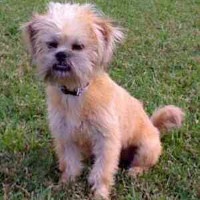 |
Lhaffon |
|
He is not recognized by the F.C.I. |
Origin |
Tibet <> Belgium -> U.S.A. | |
Translation |
Francis Vandersteen |
A brief presentation of the Lhaffon |
| The Lhaffon is a hybrid cross between a Brussels Griffon and a Lhassa Apso, both of which are miniature breeds. They're likely to stand only around 25.5 centimeters tall, weigh around 7 kilos on average, and have long, silky coats that are usually black, brown or red, but can also be cream, fawn, white, gray, sable or brindle. They are intelligent and friendly for the most part, but do better with older children than younger ones, as they tend to be snarling when too aggravated. Training them can be difficult, as they can have problems with domestication, but with patience and positive reinforcement, your dog should learn quickly. |
History of the Lhaffon |
| The Lhaffon hasn't been around long enough to have its own history, so it's best to look at the history of its parent breeds. |
A little of the Lhassa Apso |
||
| Buddhist monks living in the Tibetan mountains developed the Lhassa Apso as sentinels for temples and monasteries. Some believe the dogs are descended from Tibetan Terriers, while others think the breed may have been influenced by dogs from the North. After studying the breed's DNA, it seems that one of the Lhassa Apso's ancestors could be a type of mountain wolf. The breed was developed to withstand cold temperatures, and their judgment helped them determine whether someone approaching was friend or foe. Dogs of the breed were never sold, although the Dalai Lamas occasionally gave a pair to imperial families and visiting dignitaries. In 1933, the breed arrived in the United States when the 13th Dalai Lama presented a group of small dogs to Mr. and Mrs. Suydam Cutting. The beginning of the breed in the USA came from these dogs, and the breed was recognized by the American Kennel Club in 1935. | ||
 |
||
| Standard of the Lhassa Apso | ||
A little of the Brussels Griffon |
||
| The Brussels Griffon originated in Belgium in the 1800s from several breeds such as the English Toy Spaniel, Pug, Affenpinscher, Griffon d'Ecurie and perhaps even the Yorkshire Terrier. They were originally bred to get rid of small vermin such as rats and mice from stables and houses, but eventually became companions when cab drivers in old horse-drawn cabs took them along to deter theft. Although they are small dogs, they have robust bodies and are very brave. Many say they resemble the Ewoks from Star Wars and that their human expressions are similar to those of the Pug. There are two types, smooth-coated and rough-coated, but apart from that, both are the same breed. The breed became instantly famous after starring in the 1997 film “As Good As It Gets” with Jack Nicholson and Helen Hunt, but they were recognized long before that, in 1910, by the American Kennel Club. They are the 97th most popular dog breed in America. | ||
 |
||
| Standard of the Brussels Griffon |
Appearance of the Lhaffon |
| The Lhaffon's dark brown eyes are large, round and intelligent. Their drooping ears are triangular and hairy, and they have a short muzzle with a black nose. Their short muzzle tends to cause brachycephalic syndrome, which is a respiratory abnormality, so you should have your dog checked as soon as possible for any breathing difficulties. Their long fur can be just about any color, including black, gray, brown, red, cream, fawn, white, sandy, brindle and any combination of these. Some Lhaffons have a stiff or rough coat, but they are generally soft and silky like the Lhassa Apso. |
Temperament of the Lhaffon |
| Because these dogs tend to mock children when teased or aggravated, they do best with adults and older children. They get on well with other pets, but need to be socialized early as they like to be the center of attention. The Lhaffon is generally cautious with strangers, so can be wary or even aggressive with visitors if not properly trained. They make good watchdogs and will certainly alert you when there's a stranger or other threat nearby. Their training may take a little longer than other dogs, but it can be done with time and patience. Do not use physical punishment, as this will provoke aggression in your dog. Positive reinforcement is preferable when training. |
Needs and activities of the Lhaffon |
| Your Lhaffon doesn't need much exercise, but he does tend to be lazy and overweight. So you need to make sure he gets at least 30 to 45 minutes of vigorous activity every day. This breed loves to play fetch and can even be good at agility training. So you can try this and take him for a short walk twice a day, which should be enough for one day. However, if they don't get enough exercise, they tend to get bored or anxious and can develop bad habits such as excessive barking, chewing on objects or even becoming aggressive. |
Maintenance of the Lhaffon |
| Lhaffons should be brushed daily or at least every other day with a pin brush and metal comb to prevent tangling. Depending on their fur type, their coat may need to be stripped every few months to get rid of dead hairs. You can do this by hand, or use a tool called a stripping blade. In addition, you should clean his ears with a damp cotton ball once a week and look for signs of irritation or wax build-up. Bathing is only necessary every few months or so, as bathing too often can dry out the skin. Be sure to trim your dog's nails as needed and brush his teeth with a special dog toothpaste once or twice a week. |






 English (United Kingdom)
English (United Kingdom)